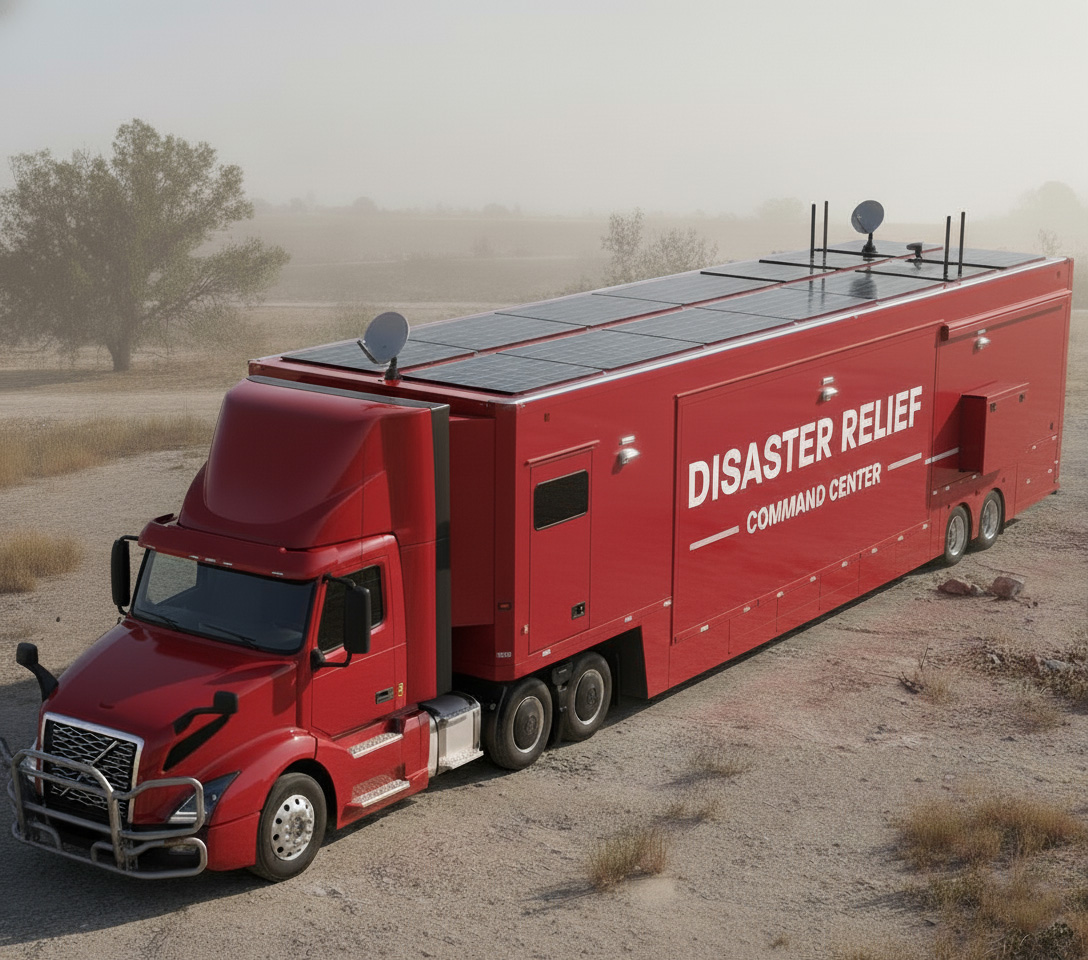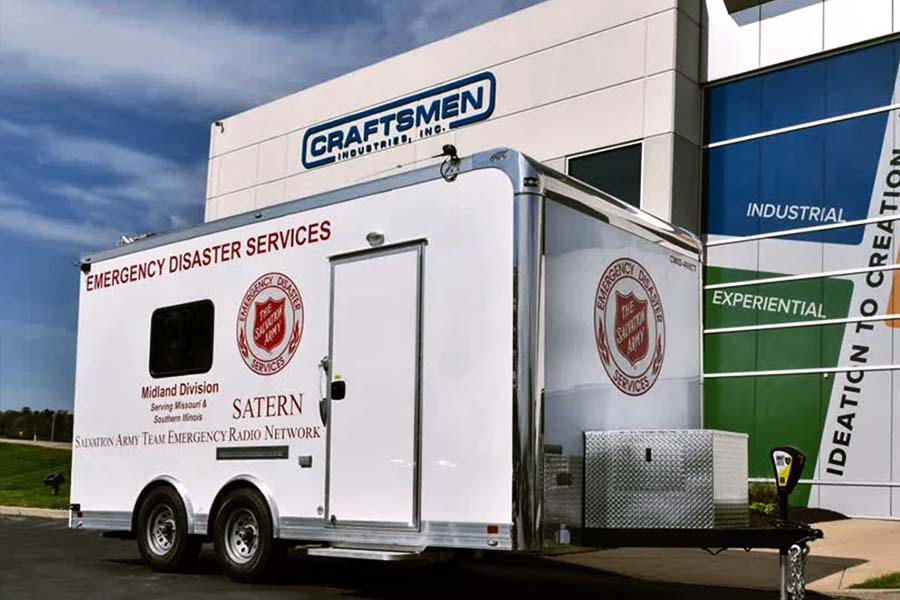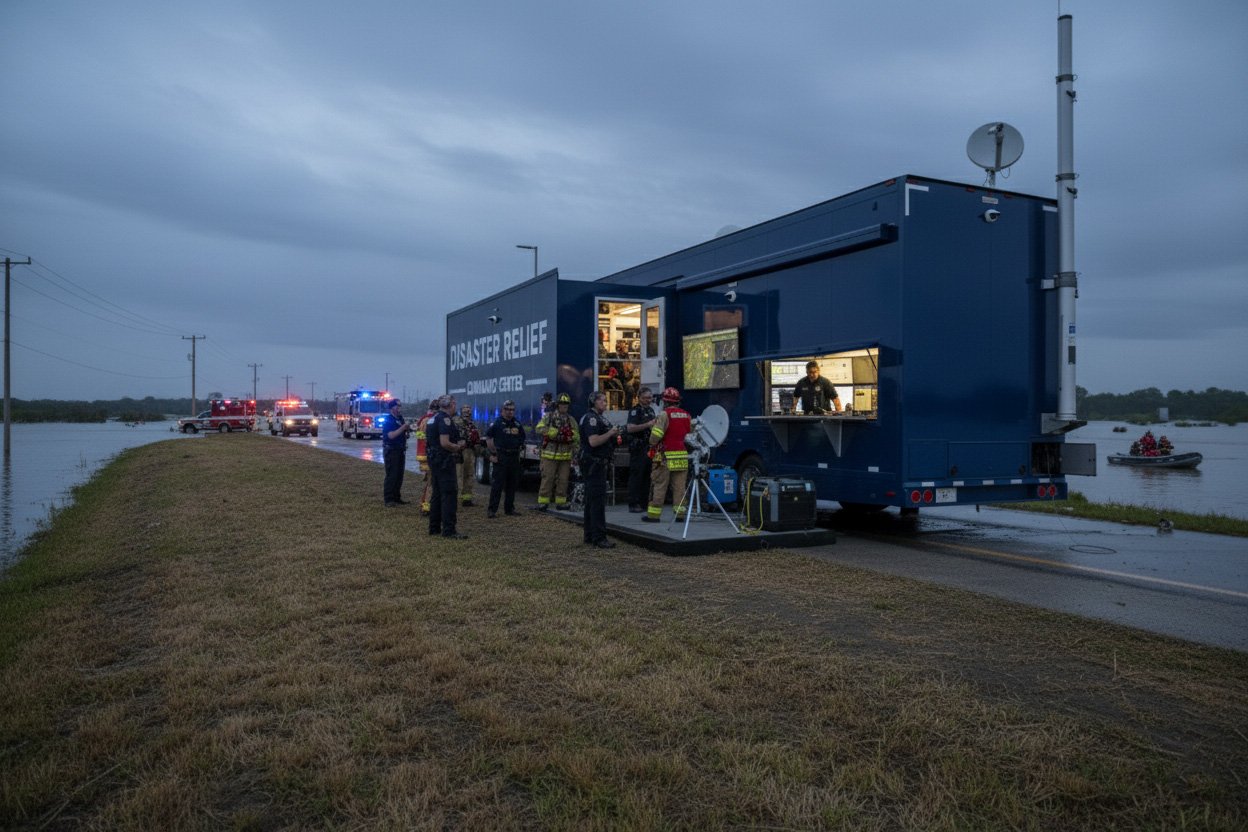How to Protect Mobile Command Centers Against Cyber Attacks?
Modern Mobile Command Centers (MCCs) are critical in public safety, providing efficient emergency responses and coordination during crises. Yet,...
11 min read
Craftsmen Industries Nov 20, 2025 1:43:28 AM

In an increasingly unpredictable world, where real-time coordination and situational awareness can mean the difference between control and chaos, Mobile Command Centers (MCCs) have emerged as indispensable assets. These highly specialized mobile units act as operational headquarters on wheels, enabling communication, data analysis, and decision-making even in the most remote or crisis-hit regions. From emergency response and military operations to live broadcasting and disaster recovery,
The global demand for mobile command-and-control technology reflects this shift toward rapid, tech-driven mobility. According to Future Market Insights, the Mobile Command and Control Solutions Market is projected to grow from USD 29.8 billion in 2025 to USD 58.6 billion by 2035, at a CAGR of 7.0%. This exponential growth highlights how industries worldwide are investing in advanced command infrastructures to strengthen security, communication, and operational resilience.
This article explores how innovative design, precision engineering, and robust fabrication combine to create mobile command centers that are not only durable and intelligent but also fully equipped to handle the complex demands of 21st-century operations. Without any delay, let’s move towards the article.

A Mobile Command Center (MCC) is far more than a specialized vehicle; it is a fully functional, technology-equipped operations hub designed to provide command, control, and communication capabilities wherever they are needed most. Built on platforms such as trucks, trailers, buses, or armored chassis, these units are engineered to replicate the operational environment of a stationary headquarters but with the crucial advantage of mobility.
A vehicle qualifies as a command center at its core when it integrates four essential components: connectivity, coordination, control, and continuity. These pillars transform an ordinary mobile platform into a self-contained operations base capable of real-time managing critical situations.
From a functional standpoint, MCCs serve as communication and coordination bridges between on-site teams and central command facilities. In large-scale emergencies, such as hurricanes, wildfires, or security incidents, when infrastructure is compromised, MCCs become the backbone of connectivity. They provide interoperability between different communication standards, ensuring that fire, police, medical, and military units can operate cohesively.
The true advantage of a Mobile Command Center (MCC) lies in its ability to move, adapt, and operate wherever and whenever required. Below are some of the most critical reasons why mobility remains central to MCC design and deployment:
The versatility of mobile command centers (MCCs) means they are deployed across a wide range of industries, each with distinct mission profiles, technology demands, and operational environments. Below are five major sectors where MCCs have become mission-critical, along with real-world statistics that highlight their increasing importance.
In emergency management, MCCs serve as rapidly deployable incident command posts when fixed facilities are impaired or inaccessible. They provide a mobile headquarters for coordinating rescue, relief, and recovery. According to a recent study, the mobile command center was the most frequently cited specialized technology among first-responder disciplines, appearing in approximately 10.9 % of responses across fire-fighting, law enforcement, EMS, and other groups.
Typical uses include coordinating multi-agency operations after hurricanes, wildfires, or large-scale accidents: mapping field units, managing logistics, relaying communications, and establishing a unified command-and-control node on-site.
For defence applications, MCCs are built with robust, secure communications, hardened chassis, and intelligence integration. In this domain, the demand is strong: One market report shows that military and defense applications of mobile command center technology are among the fastest-growing segments, driven by the need for mobile, secure, and resilient command posts.
These units are used for battlefield command and control, intelligence fusion, drone integration, and secure satellite/mesh networks, enabling commanders to manage assets, surveil areas, and coordinate missions in real time, even in contested or remote environments.
Law enforcement agencies use MCCs as mobile op-centres at crime scenes, hostage or barricade situations, major public events, or for riot control. The law-enforcement segment accounted for more than 33% of total market revenue for mobile command-vehicle applications in 2024.
Features often include secure communications, video walls for surveillance feeds, briefing rooms, forensic workstations, and rapid-deployment capability. By positioning these platforms on-scene, agencies can reduce delays, increase situational awareness, and make more informed tactical decisions.
In the broadcasting world, MCCs (or broadcast trucks, command vans) serve as mobile production studios and transmission hubs for live events, sports, breaking news, and remote broadcasts. Though less quantified in public market reports than in emergency/defense, industry commentary confirms the broadcast/event use of MCCs for seamless connectivity, real-time editing, and feed distribution.
At large concerts, sports arenas, or political rallies, a mobile command unit allows production teams to edit, transmit, switch feeds, monitor cameras/drones, and communicate with remote crews, all while being physically at the event location.
Designing a Mobile Command Center (MCC) is not just about mounting technology onto a vehicle; it’s about translating mission objectives into engineering precision. Whether the client is a police department, defense agency, or broadcasting network, each MCC must balance mobility, capability, and sustainability. This section explores how thoughtful design, from needs assessment to power architecture, transforms function into form.
Every successful MCC begins with a deep understanding of its mission. Engineers collaborate closely with clients, often emergency managers, military officials, or broadcasters, to define operational goals, such as surveillance coverage, communication bandwidth, or on-site coordination.
Organizations such as FEMA or large police departments define their scope precisely, requiring, for example, the ability to deploy within 60 minutes and support multi-agency communication through LTE and satellite. Clear planning ensures that every inch of the vehicle serves a mission-critical function.
Once the mission is defined, the next challenge is to optimize the limited space for maximum functionality. Designers carefully plan zones for workstations, briefing tables, and equipment racks, ensuring smooth workflow and easy access.
Modern MCCs often use modular slide-outs to expand workspace and increase interior capacity by up to 30%. Ergonomic design remains central, and proper lighting, ventilation, and seating reduce fatigue during long shifts.
The vehicle's exterior determines its mobility, stability, and survivability. Designers choose from heavy-duty trucks, RV platforms, or semi-trailers depending on terrain and payload requirements. Weight distribution is calculated to prevent instability when the vehicle is stationary or traversing uneven ground.
According to a 2024 market report, truck-based MCCs account for over 41% of global deployments, reflecting their superior off-road performance and load-bearing capacity. The design also varies by industry: defense units may feature camouflage coatings and armored exteriors, while broadcasting vehicles emphasize branding and visibility.
A mobile command center is only as strong as its power and communication backbone. Modern designs integrate hybrid energy systems, combining diesel generators with solar panels and lithium batteries to minimize noise and fuel use. Some setups achieve up to 60% reduction in operational costs through smart load management.
Connectivity redundancy is another design pillar. Engineers include satellite uplinks, LTE/5G routers, radio mesh networks, and onboard Wi-Fi to ensure uninterrupted communication in any terrain.
Mobile command centers only come to life when the design moves from blueprint to build. This phase blends advanced engineering, precision fabrication, and rigorous testing to deliver a mobile operations hub that meets mission demands.
The following subsections break down the key steps: fabrication process overview, material fabrication techniques, interior fit-out and system integration, and quality testing & validation.
The journey from concept to deployment begins with detailed 3D modelling and CAD engineering. Manufacturers create virtual prototypes that simulate vehicle layout, equipment placement, and load distribution.
Once the design is validated, the vehicle chassis is modified and the shelter structure fabricated, either as a custom build or using modular assemblies. Custom fabrication (frames, support structures, unique slide-outs) offers higher performance and tailored capabilities, while modular assembly (pre-built modules, container-style bodies) enables faster turnaround and lower cost.
Throughout this process, engineers monitor structural, electrical, and ergonomic parameters to ensure that what was planned in CAD works in practice. The result is a vehicle with the architecture and fit-out ready for mission-specific technologies, all anchored in a robust structural shell.
High-precision fabrication methods underpin the reliability of mobile command centers. Techniques such as CNC machining, laser cutting, and automated welding enable the manufacture of complex panels, bespoke brackets, and structural frames with tight tolerances. These techniques ensure components meet durability and repeatability standards required in challenging field conditions.
The use of these materials and fabrication methods supports mobility (improved off-road capability and lower centre of gravity), fuel efficiency, and longer service life. The fabrication phase ensures all mechanical, thermal, and structural elements are integrated into the vehicle body before system fit-out begins, laying the foundation for the interior and system integration steps that follow.
With the vehicle shell in place, the interior fit-out transforms it into a fully operational command hub. This stage involves installing communication racks, operator consoles, IT infrastructure, fiber-optic runs, power wiring, ventilation systems, and electronics enclosures.
Electrical wiring must adhere to automotive and mobile-unit standards: surge protection, grounding, EMI shielding, and redundancy are critical. Fiber-optic or shielded copper cabling supports high-bandwidth video walls and operator consoles. Finishes include anti-static floors, soundproof walls, ergonomic seating, and optimized lighting to support long-duration operations. The goal is to ensure a seamless human-machine interface, minimize fatigue, and maximize mission performance.
Before delivery, mobile command units undergo thorough testing to validate performance, reliability, and mission readiness. Pre-deployment tests include communication-range checks (satellite, LTE, mesh networks), full-load power-system testing, environmental chamber simulations, vibration and shock tests, and field trials.
This rigorous validation ensures that when the vehicle arrives on-site, it isn’t just a near-mission capable platform; it is fully mission-ready, validated for real-world operations, and backed by manufacturer support and logs.

Modern Mobile Command Centers (MCCs) are no longer just vehicles, they’re digitally networked command ecosystems. The seamless integration of communications, surveillance, automation, and cybersecurity enables commanders to operate confidently in real time, even in disconnected, high-threat, or infrastructure-compromised environments.
This technological backbone transforms an MCC from a mobile office into a self-contained nerve center for mission execution.
At the heart of every MCC is a resilient communication infrastructure designed for uninterrupted connectivity. This includes satellite uplinks, 5G, mesh networks, and interoperable radio systems that ensure communication across agencies and terrains.
Redundancy is a critical design element. Systems feature automatic failover between communication channels, if a 5G network drops, the system instantly switches to satellite or radio mesh without human intervention. Such multi-layered connectivity ensures operational continuity, whether the MCC is deployed in a warzone, at a flood site, or during a city-wide blackout.
A modern MCC’s power lies in its situational awareness suite, a combination of real-time video walls, PTZ cameras, aerial drones, and on-vehicle sensors. These systems capture and stream live data to the command console, where it is visualized for decision-makers.
Many MCCs now feature AI-enhanced analytics that support real-time threat detection and automated event correlation. AI-powered security cameras have been shown to reduce false alarms by up to 90% and improve threat detection rates in modern video surveillance systems, allowing operators to focus on verified incidents and mission-critical decisions.
Automation represents the next frontier of MCC technology. Through AI-driven decision support, IoT diagnostics, and smart energy management, MCCs minimize manual workload and optimize system uptime.
Cloud-based command software further extends these capabilities. Command data, video feeds, and reports can sync automatically to secure cloud environments, allowing remote headquarters to view and manage operations in real time. This seamless integration ensures operational alignment between the field and central control.
With so many connected systems, cybersecurity is not optional, it’s mission-critical. MCCs operate in dynamic, often contested digital environments and must defend against intrusion, jamming, and data theft.
To counter these threats, MCCs employ end-to-end encryption, zero-trust architectures, and AI-based intrusion detection systems. Encrypted VPN tunnels and hardened firewalls protect communication channels from interception. A 2024 defense tech report highlights that 78% of next-generation MCCs now include AI-based cyber anomaly detection and continuous monitoring capabilities.
As Mobile Command Centers (MCCs) evolve, they are increasingly aligning with sustainability goals and adapting to technological advancements. The integration of eco-friendly materials, digital simulation tools, autonomous capabilities, and market growth projections are shaping the future of MCCs.
The adoption of lightweight composites and recycled materials in MCC construction is reducing environmental impact. These materials not only lower the carbon footprint but also enhance fuel efficiency and mobility. Additionally, the integration of solar panels and hybrid power systems is enabling MCCs to operate off-grid, reducing reliance on traditional fuel sources and minimizing emissions.
The implementation of digital twin technology allows for the creation of virtual prototypes of MCCs, facilitating real-time simulations and performance analysis. This approach enables engineers to optimize design, anticipate potential issues, and improve overall efficiency before physical construction begins.
The future of MCCs includes the development of autonomous and remote-controlled units. These vehicles can operate with minimal human intervention, enhancing safety and efficiency in hazardous environments. The integration of advanced sensors and AI algorithms enables real-time decision-making and adaptive responses to dynamic situations.
The global Mobile Command Center market is experiencing significant growth. According to a report by Growth Market Reports, the market size reached USD 2.94 billion in 2024 and is projected to grow at a CAGR of 7.2%, reaching USD 5.51 billion by 2033. This growth is driven by advancements in communication technology, increased demand for rapid deployment in disaster response, and heightened security concerns worldwide.
Mobile Command Centers (MCCs) represent the perfect convergence of engineering precision, technological innovation, and mission-driven design. From initial needs assessment and CAD modeling to advanced fabrication and system integration, every stage contributes to creating a self-sustaining, mobile hub capable of operating in the most challenging environments.
These command units empower emergency responders, defense forces, broadcasters, and utility operators to maintain communication, control, and situational awareness in critical moments.
As industries seek reliable and future-ready solutions, Craftsmen Industries stands out as a trusted partner in the design, engineering, and fabrication of state-of-the-art Mobile Command Centers. With decades of expertise, custom manufacturing capabilities, and a commitment to innovation, Craftsmen delivers mission-specific MCCs built for durability, performance, and precision.
Whether your goal is to modernize emergency response, enhance military command mobility, or create broadcast-ready platforms, Craftsmen Industries transforms your operational vision into a mobile reality.
Mobile Command Centers (MCCs) are critical for organizations that require real-time coordination and control in the field. They allow agencies to maintain communication, manage operations, and make timely decisions during emergencies, large-scale events, or tactical missions, even in areas with limited infrastructure.
MCCs are utilized by law enforcement, emergency responders, military and defense units, utility companies, and event security teams. They are deployed for disaster management, crime scene operations, field coordination, and large public events, providing a centralized hub for all critical communication and decision-making.
Modern MCCs combine advanced technologies with mobility to enhance operational effectiveness. They integrate satellite and cellular communication systems, real-time video surveillance with drones and PTZ cameras, AI-enabled analytics for situational awareness, and self-sustaining power solutions including generators and solar panels. These capabilities allow MCCs to function reliably in diverse environments and mission scenarios.
The cost of an MCC depends on its size, level of customization, and onboard technology. Smaller, basic units may cost tens of thousands of dollars, while highly customized, fully equipped command centers can run into several million dollars. Agencies typically consult with manufacturers to define requirements and obtain tailored quotes.
Most MCCs with a Gross Vehicle Weight Rating (GVWR) under 26,000 lbs can be operated with a standard driver’s license. Larger vehicles or those with significant modifications may require a commercial driver’s license depending on local regulations.
Maintaining an MCC involves regular inspections of hardware, software updates for communication and surveillance systems, and ongoing training for operators. Ensuring that both the vehicle and its technology remain operational is critical for reliability, safety, and mission readiness.
While both serve command functions in the field, MCCs are typically larger, sometimes stationary units like trailers or buses, designed for extended operations with comprehensive facilities. Mobile Command Vehicles (MCVs) are smaller, truck or van-based units intended for rapid deployment, offering greater flexibility and speed for dynamic operational scenarios.

Modern Mobile Command Centers (MCCs) are critical in public safety, providing efficient emergency responses and coordination during crises. Yet,...

When a mobile command center doubles as an office, productivity hinges on intelligent design. These units are more than vehicles with desks; they are...

When natural disasters strike, chaos and disruption follow. Traditional communication networks collapse, mobility becomes restricted, and...